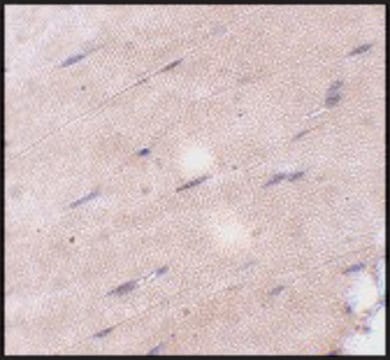SAB4200824
Anti-TFE3 antibody, Mouse monoclonal
clone TFE3-37, purified from hybridoma cell culture
Synonym(s):
Class E basic helix-loop-helix protein 33, Transcription factor E3, bHLHe33
About This Item
Recommended Products
biological source
mouse
antibody form
purified from hybridoma cell culture
clone
TFE3-37, monoclonal
form
buffered aqueous solution
mol wt
60 kDa
species reactivity
human, mouse, bovine, rat, canine
packaging
antibody small pack of 25 μL
concentration
~1 mg/mL
technique(s)
immunoblotting: 1.5-3 μg/mL using human A549 cells extract
isotype
IgG1
UniProt accession no.
shipped in
dry ice
storage temp.
−20°C
target post-translational modification
unmodified
Gene Information
human ... TFE3(7030)
General description
TFE3 serve an important role in cell growth, cell proliferation, cellular adaptation to starvation and cellular response to ER stress. Under nutrient-rich conditions, TFE3 is located in the cytoplasm, and under starvation conditions or treatment with ER stressors, TFE3 rapidly translocates to the nuclear. In the nuclear localization, TFE3 mediates cellular adaptation to stress by simultaneously promoting lysosomal biogenesis, autophagy induction, as well as expression of critical mitochondrial and metabolic regulators. It been shown that TFE3 also participate in the transcriptional regulation of the innate immune response.
Pathogen infections promote TFE3 nuclear translocation, thus inducing In vivo expression of several cytokines and chemokines.
Application
Physical form
Other Notes
Disclaimer
Storage Class
10 - Combustible liquids
wgk_germany
WGK 1
flash_point_f
Not applicable
flash_point_c
Not applicable
Certificates of Analysis (COA)
Search for Certificates of Analysis (COA) by entering the products Lot/Batch Number. Lot and Batch Numbers can be found on a product’s label following the words ‘Lot’ or ‘Batch’.
Already Own This Product?
Find documentation for the products that you have recently purchased in the Document Library.
Our team of scientists has experience in all areas of research including Life Science, Material Science, Chemical Synthesis, Chromatography, Analytical and many others.
Contact Technical Service








